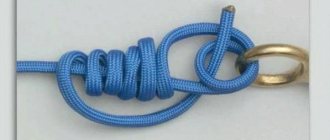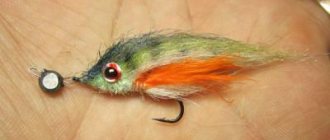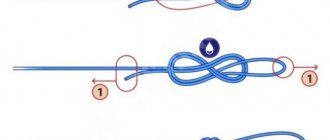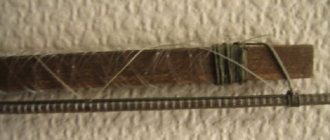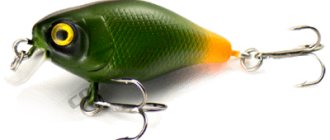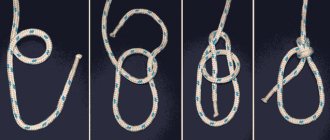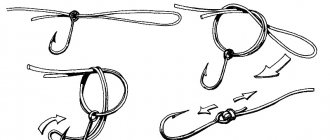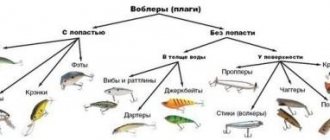Classification and characteristics of wobblers
All models have their own special characteristics by which they are classified.
There is no general table for all baits, but all spinning anglers who decide to fish with wobblers need to know about the most common ones by which they are distinguished. In the future, this knowledge will help you decide on the choice of the right bait for fishing in certain conditions. I will highlight the following characteristics:
- Body shape.
- Degree of buoyancy.
- Deepening.
- Oscillation frequency.
- Color.
- Noise chamber.
- Long-distance casting system.
Body shape and degree of buoyancy
At this time, there are many names of wobbler models, such as FAT, CRANK, SHED, MINNOW, WOLKER, SLIDER, POPPER and a lot of other new names, which are becoming more and more every year. The main criterion by which they are distinguished is the shape of the bait’s body. As a rule, the body shape copies the food item of a particular predator, but there are exceptions. For example, in our reservoirs it is difficult to find a living analogue of excessively long minnows of 15 cm, but pike and pike perch bite quite well on them.
In some cases, the form contains some kind of zest that makes the bait look like a wounded or sick fish. This slight deviation from the standard form provokes our pike well, which tries to choose a weakened or diseased object for its attack.
You can clearly see this in many models of crankbaits, which have either a pot-bellied tummy or a broken spine. If you use this bait with stops, the similarity will be obvious - the sick fish has become very weak and has begun to float or sink. For our aquarists, this behavior of a sick fish should be very familiar.
All of them are manufactured in three versions - floating, sinking and floating in the water column (suspenders). This allows us to choose the most suitable bait for certain fishing conditions. For example, in the shallows, the best option would be to choose a floating wobbler or suspender, since the sinking one will collect algae and other bottom debris when stopping. In snags, you definitely need to take only floating models, which, when stopped, will float up and make it possible to get around the snag, while avoiding getting caught.
Suspenders are a separate group - these are wobblers with neutral buoyancy that allow the bait to hang in the water column. This hovering property always helps a lot, especially when the fish is passive and does not respond to active wiring. During a pause, such a fish stands still and gets on the nerves of the passive fish, forcing it to attack the prey frozen in place.
And finally, the smallest group has sinking characteristics. Mostly these are deep wobblers for bottom wiring. Such baits are given time to sink (placed on the bottom) and only then the retrieval begins. This can be either a stepped jig (a couple of turns of the reel - a pause while touching the bottom) or a jerk twitching one. A huge disadvantage of all sinking models is increased grip and, as a result, frequent breaks of expensive bait.
Wobblers with long-distance casting system
The first wobbler was patented by the American James Haddon in 1902. One day, he was planing boards on the shore and noticed how the fish reacted vividly to sawdust falling into the water. After that, he experimented for 8 years and eventually designed a new wooden fishing lure. Over time, many manufacturers began to produce wobblers and they have undergone many changes and improvements to provide maximum fishing results. Wobblers can be used in any conditions, for any type of fishing and for any predator. You just need to choose the one that suits you best.
Now almost all wobblers are made of plastic, but there are also wooden and foam models, but they are short-lived.
There are three types of wobblers according to the level of immersion in water:
- Floating - they work on the surface of the water, there are "Slow Floating" (SF) - they float up slowly after casting, "Floating" (F) - floating, "Fast Floating" (FF) quickly float up after casting.
- Sinking - after casting, they sink to the bottom. There may be “Sinking” (S) - a sinking wobbler, “Fast Sinking” (FS) - a fast sinking one, “Slow Sinking” (SS) - gradually sinking to the bottom after casting.
- Suspender - capable of diving to shallow depths without additional weighting. There are “Suspending” (SP) or (SU) - with neutral buoyancy, “Super Slow Sinking” (SSS) - baits that sink very slowly.
Also, wobblers differ in depth:
- Surface SSR (Super Shallow Runner) - up to 1 m depth;
- Medium depth SR (Shallow Runner) - about 1.5 m;
- Deep-sea MDR - going at medium depth (Middle Deep Runner) or DR - deep diving (Deep Runner) - can go deep to 2.5 m, 3 m, 12 m.
The color of the wobbler also matters. It can have a natural color that is suitable for catching peaceful fish or an acidic bright color that attracts predators or is used in turbid waters and poor lighting.
The design of wobblers is quite diverse. This affects his game during the retrieve, and also depends on the tastes of the predator.
- Minnow is a slender, elongated form, similar in appearance to a small fish such as a minnow. It has good controllability and is suitable for hunting pike, perch, pike perch, and asp.
- Shad - it is flatter and taller than the minnow, shaped like a herring. It works well in bodies of water with a current, if it is sinking, or in standing water, if it is floating.
- Fat (Fat) - the body shape resembles a drop, more voluminous and shorter. Suitable for an active predator at a depth of up to 1.5 m.
- Crank - similar to fat, but more elongated. It has a high-frequency play, suitable for both calm water and bodies of water with current. It attracts trout, chub and perch well.
- Popper - shaped like “pencils” - elongated cylindrical wobblers or “cone” - more pot-bellied, similar to bleak, roach, perch. Effective in shallow water or in a reservoir with a lot of algae when fishing for pike, perch, chub, asp.
- Jerkbait is a large, heavy wobbler, suitable for jerking, alternating stops. Due to their size, they are good at luring predators from the depths when trolling.
- Rattlin is a flat wobbler without a blade, inside there is a small ball that creates a rattling sound when played, the vibration amplitude is small. Suitable for catching perch, pike, pike perch, especially when the water gets cold.
- Darter is a long narrow body without a blade. The front part is cut at an angle from above. Has low frequency play.
- Stickbait is a wobbler without a blade that has a long, even shape resembling a stick. Suitable for fishing near the surface of the water.
- Joints are wobblers that have a different configuration of two or three parts, connected by a hinge.
- Swimbait is a wobbler consisting of several parts, connected by a hinge and made of a softer material.
- Cicada - wobblers made in the shape of various insects, frogs, rodents.
You can choose a wobbler for the conditions and object of fishing, but in many respects, the result depends on the game and the method of fishing. Therefore, it makes sense to try several options and understand which one will be more effective for you. You can choose a wobbler in our catalog on the online store website. All prices are valid both for the retail network and for online orders.
Wobbler deepening
Each bait has its own working depth (or horizon) of wiring, which is indicated on the packaging. There are surface, shallow, deep and something in between, located in the range between deep and shallow with a depth of 2-3 meters.
Let's start with the superficial. The depth of such baits is zero, the wiring is at the border of air and water. The most striking example is a variety called popper. Fishing takes place in front of the fisherman, all attacks of the fish are clearly visible, which makes fishing very exciting and unforgettable. With each bite, the heart skips a beat and is accompanied by a frantic surge of adrenaline. Posting a popper is an alternation of jerks and pauses with accompanying “plops” of the popper. This is quite noisy fishing, which our perch simply loves.
You can also fish with surface baits using a uniform retrieve. For example, all kinds of imitations of mice and, in some cases, frogs with zero depth. They are good in shallow water overgrown with water lilies and near steep cliffs, from which careless living counterparts sometimes fall.
Shallow-water ones, with a depth of up to a meter, are used naturally in shallow water, in the coastal (coastal) zone, as well as when catching predators in cauldrons (active hunting areas). In other cases, fishing with shallow-water baits will most likely be the exception to the rule.
In this group you can most often find suspenders, as they are the most popular among fishermen. The fish stands quite densely in the coastal strip or on the border of algae and only a long pause in the retrieve without sudden movements can force it to bite.
Next we will consider baits with a depth of 2 meters or more. Visually, deep-sea wobblers differ from others by the large blade that is located in the front part. They have a lot of drag and almost all have their own active game. For them, you need to choose a spinning rod with an increased test load range.
The main wiring is the usual uniform one; you can diversify the game with rare jerks (twitching) or temporary stops in the wiring, after which fish bites very often occur.
I will also mention that when fishing from a boat in the lane (or trolling), the bait moves a little deeper than indicated on the box, and when fishing from the shore, the depth of immersion may vary depending on the following factors:
- wiring speed;
- spinning position;
- presence of current.
That is, if the box says immersion depth is 2 meters, focus on the extended range of use - approximately 1.5-2.5 meters. Everything is extremely simple with floating models: the slower you turn the reel handle, the higher the bait goes, and the higher the tip of the spinning rod, the higher the bait goes. With sinking baits it’s a little different. If the position of the spinning rod has the same effect, then with the speed of the retrieve it’s the opposite - the faster you turn the handle, the higher the wobbler will go.
The speed of the current also greatly affects the depth of the dive. With the current - a floating wobbler will float higher, against - it will dive deeper.
Casting with wobblers
You can catch fish using wobblers in various ways. In this article we will dwell in detail on casting fishing.
You can catch predatory fish by casting with a wobbler both from the shore and from a boat.
Fishing from the shore is more democratic. Anyone can fish this way. And if you wear rubber waterproof boots or special overalls, then such fishing can almost be equated to fishing from a boat! First you need to decide on the fishing location. Each type of predator has its own favorite habitats. For example, for pike these are grassy thickets, reed borders, and water lilies. But pike perch, on the contrary, will prefer to exit the hole and roll. Hard bottom, with driftwood at the bottom and current.
The perch will delight the angler with its quantity, bright bites and fierce resistance. This fish feeds in large schools, often forming "cauldrons". Don’t yawn here, you won’t be without a catch! Catfish live in deep pools and emerge from them into shallow water only at dusk. Taking into account our lifestyle and habits, we will select our bait for catching different predatory fish.

To catch pike ambushed in the grass, we use wobblers that do not dive deep. Floating type. With an immersion depth of up to half a meter. Or even walking on the surface. The color of the wobbler depends on the activity of the fish. Natural if active and bright, provocative if passive. It is preferable for the bait to have a sluggish, sweeping action. It is necessary to use a special leash that protects the bait from being cut.
For pike perch, colors must be selected according to the same rule as for pike. But let’s take deeper-sea wobbler models. Priority will be given to sinking models. So that the wobblers work at the very bottom. The game should be energetic, high-frequency. And the shape of the bait should be narrow, oblong. This is due to the structural features of the fish’s pharynx. A wide one simply won’t fit in there. No leash needed.
A wobbler that floats is perfect for perch; it is called a “popper”. It imitates the behavior of the hunting perch itself. It can also make peculiar gurgling sounds. Special flies are tied on poper hooks. They additionally provoke a predator. If a pike is nearby, it will definitely attack your bait, so it is advisable to have a special leash for catching the predator. So that the pike does not cut it off with its teeth.
There is no way to catch a catfish from a hole during the day, from the shore. You need to wait until dusk. And then come to the edge of the pool, a section of the river with a reverse flow or a shallow near a deep hole. If you attach a large wobbler and bright colors to the spinning rod, then the mustachioed giant will not resist. The wiring depth may vary. Catfish hunt in all layers of water. A special leash is also necessary, as when fishing for pike.
The above applies to the summer season.
Casting wobblers from a boat follows the same principles as from the shore. But you can choose almost any place for fishing. With a boat on the pond you are already a king! There is a nuance - when approaching the fishing spot, do not make noise. Especially in shallow water areas. And you need to approach perch “cauldrons” very quietly. Preferably by oars.
In conclusion, some practical tips:
• Pike is a daytime fish. Don't try to catch her in the middle of the night. Sunrise and sunset are best. But in cloudy weather you can fish all day. The same applies to perch.
• The rule for pike is that the worse the weather, the more confident the bite.
• It is better to catch pike perch at dusk and at night. It’s better on a shoal, close to a hole. The weather should be smooth and stable.
• I do not recommend catching catfish from the shore. He'll bite. But you are unlikely to get it out. But from a boat is another matter!
I recommend paying close attention to wobblers. Lures of this type must be in the fishing kit of every understanding fisherman, and almost always you will be guaranteed a catch.
Oscillation frequency
Depending on the specialization (object of fishing) of the wobbler, they may have different oscillation frequencies. This characteristic is created jointly by the body shape and the blade of the bait. The wobbler can be high-frequency, mid-frequency, low-frequency, or have no frequency play at all.
High-frequency ones are most often used when fishing for perch and chub, and low-frequency ones, with a wide sweeping amplitude of movement, are very popular with pike.
Some baits do not have their own active game and you may mistakenly think that you bought a defective product.
Don't rush to take it back to the store. For these wobblers, jerk wiring is used - twitching, if it is MINOW or some other techniques (jerking, jig). In principle, you can always find out in advance about the characteristics of a particular model from the seller or read on the Internet. Later you will be able to distinguish them by sight.
How to load it yourself?
The weight is increased by changing the wobbler equipment to a heavier one.
The load affects the buoyancy of the wobbler. Therefore, a preliminary test is carried out at home. In this case, the viscosity of water is taken into account: the indicator varies depending on the time of year and temperature.
Replacing a tee
Standard or factory hooks are quite light. The simplest adjustment of a wobbler is to reinstall the tees. For replacement, choose hooks made of heavier metal and wire of larger diameter.
You can influence the weight of the bait with lead wire or other materials used to wrap the shanks of the hooks. But we must take into account: the larger the area of the tees, the stronger the water resistance, and this indicator affects the wiring and worsens the amplitude of vibrations.
Noise chamber and long-distance wobbler casting system
There are also silent wobblers and those equipped with a rattle. A rattle is one or more balls in a noise chamber, which, when inserted, produce an accompanying sound. By analogy with the vibration frequency, I noticed the preference of perch and chub for the sound emanating from small balls. On the contrary, pike most often attacked baits with large, heavy balls that made a dull sound.
Balls can also be used to increase casting distance. When swinging the spinning rod, such balls roll into the tail part, and with the start of reeling, they move into a special hole at the beginning of the channel or, if there is a magnetic system, they stick to a magnet. All baits equipped with a high-quality long-distance casting system fly strictly with their tail first, so when casting there is no overlap of the leash over the tees. However, for a wobbler equipped with this modernization (especially the magnetic system) you need to pay an order of magnitude higher price.
Wobblers. Long cast
Date: May 9, 2021 | 622
One of the important parameters that any spinning bait has, including wobblers, is range. The casting range of a wobbler is important when fishing from the shore and you need to reach and throw the bait to a potentially interesting point in the reservoir, or when a cautious fish is feeding on the surface, and you can’t get too close, but send the bait from afar. So what does the long cast of a wobbler ? This is what we will deal with in this article.
A wobbler is the most technologically advanced type of spinning bait for catching predatory fish. And these baits have their own characteristics of ensuring long-distance casting.
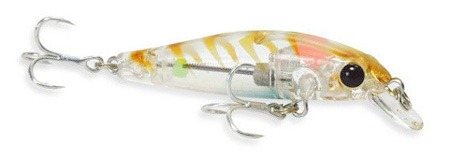
The issue of long-distance casting of a wobbler consists of two components: 1. geometry and design of the wobbler itself; 2. features of equipment and casting technique.
Let's start with the last one. Like any other bait or equipment, it is better to cast a wobbler far with properly configured gear. The correct spinning rod for long casts is:
— Quite flexible (or at least with a flexible tip) sending spinning rod;
— High-quality pass rings;
— High-quality reel with an ideal spool collar (smooth, without nicks or damage);
— Winding the cord almost right up to the collar. The spool must be full;
— Quite a thin and slippery cord.
All these are guarantees that ensure long-distance casting of the wobbler.

How do the design and dimensions of the bait itself affect the casting distance? It is clear that the more compact the bait, the more weight is contained in a smaller volume, the better. So, cranks and fats, where the center of gravity of the wobbler is closest to any point on the periphery of the bait, fly much better than minnows and shads.
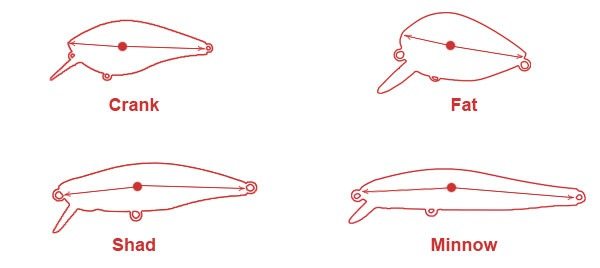
This is all provided that the wobbler is ordinary, made of balsa or plastic, but without tricky long-casting systems inside. Those. the center of gravity of such a wobbler is located approximately in the region of the geometric center of mass.
The shape and size of the wobbler blade is of great importance for positive aerodynamics. The smaller the blade of the wobbler, the less the bait flies, and the less it leads to looseness during flight. And, on the contrary, wobblers with a large blade fly simply disgustingly. And, if such a wobbler is not equipped with any long-distance casting system, then it can only be used for trolling.
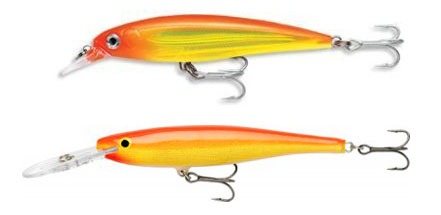
Now let's talk about the most interesting thing - about wobblers with long-distance casting systems . Seeing that many models of wobblers catch excellently, but at the same time their casting range does not stand up to criticism, the developers began to come up with various design tricks to increase the casting range.
What is the task? How to provide a wobbler with maximum casting range. It's simple. It is necessary to ensure that the bait flies strictly tail first. Then, no vibrations arise. The wobbler does not turn sideways in flight. This means that resistance is minimal in this state of affairs.
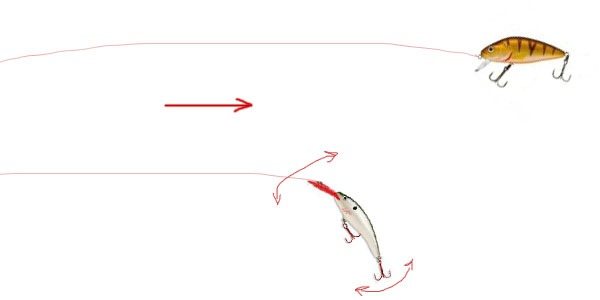
Obviously, to achieve the flight of a wobbler strictly with its tail forward, you need to place the center of gravity of the wobbler in the tail. Then, the heavier part will drag the entire body of the bait along with it.
There are models of wobblers where the nose part, the head of the bait, is loaded, directly next to the attachment point. And, also, the load, in the form of a monolithic section of plastic or a metal ball, is located in the tail.
There are such models. They fly noticeably better than usual. And, even, the developers managed to find a balance in the wobbler’s play with such a non-standard placement of mass over the volume of the wobbler.
But there are also more advanced solutions. There are wobblers, mainly made in Japan, where the center of gravity of the wobbler is shifted when casting. Such systems can be simple, based on a ball sinker moving in a special channel, or more complex, based on magnets.
The first version of the long-distance wobbler casting system. Inside the body of the bait there is a channel leading from the center to the tail of the wobbler. A rather weighty ball, which acts as a sinker, lies in its usual position in the recess, closer to the center of the wobbler. When a cast occurs, the jerk causes the ball to jump out of the recess and fly to the end of the channel. Thus, the center of gravity of the wobbler shifts to the tail. As a result, we have the correct position of the wobbler in flight, tail first, and excellent long-distance casting. When the wobbler splashes down, the ball rolls back to the middle of the bait, into its recess, and takes its working position, which gives the wobbler normal play.
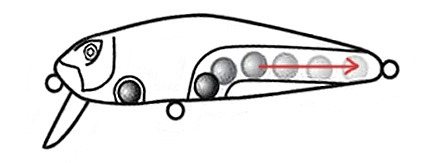
Many models, both quite expensive and quite budget wobblers from Japanese and Korean manufacturers, are equipped with such a scheme for ensuring long-distance casting. If there are successful clones of copies with such a system, because recreating this idea is not that difficult or expensive.
Option two is a long-distance magnetic casting system. This is where things get a little more complicated. Here a magnet is used to return and hold the ball in place. Again, when casting, under the influence of inertia the ball flies into the tail of the wobbler, giving it the correct position in flight. Then, when the flight stops, the ball begins to roll back and a magnet comes into action, which returns the ball-weight to its place and holds it there during retrieval so that it does not roll away and does not change the balance of the wobbler during play.
There are different options for implementing long-distance casting systems using magnets. It is clear that either an iron ball or several balls are used, one of which (the locking one) is iron, and the rest are lead or tungsten. There are even more sophisticated systems that use a guide and a combined cylindrical weight made of tungsten and a magnet moving along it.
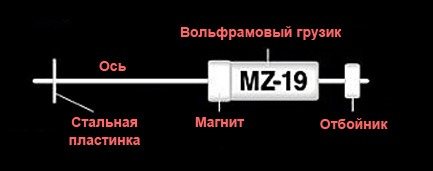
In this scheme, the weight, also, under the influence of inertia, flies along the guide into the tail of the bait. Then, when it stops, the weight is pulled back to the iron plate by a magnet. It is quite possible that over time, other interesting designs of long-range wobblers will appear and will appear.
The leaders in the construction of wobblers with long-distance casting systems, with interesting balancing systems, are, of course, Japanese manufacturers. It is due to this filling that many models of wobblers are so expensive.
What to prefer, expensive Japanese wobblers or their cheap clones? This is up to everyone to decide, based on their financial capabilities and fishing goals. There are situations when a cheap Kosadaka or Strike Pro catches perfectly. But, when you need increased range and particularly outstanding play, then wobblers with long-distance casting systems and interesting balancing are simply irreplaceable.
Share with your friends:
Category: Tackle Equipment
Tags: Wobblers, Casting, Lures, Equipment
Wobbler color
When it comes to color, everyone is their own boss. I will only say that in different bodies of water a predator may prefer completely different colors. In many ways, the choice of wobbler color depends on the following factors:
- water clarity;
- main diet of the predator;
- active (passive) state;
- Times of Day;
- season.
The huge variety of shapes and colors of the range of wobblers presented today confuses even an experienced fisherman.
Green (perch), silver (white) and gold (yellow) shades can be considered classics. Our fish take them always and everywhere. Sometimes a phosphor is added to the paint (for fishing at night or at depth). There is an opinion that the fish don’t care what color your bait is. But that's not true. Maybe when fishing for active pike.
The color of the wobbler, like the color of all other baits, can be divided into two groups, namely natural colors and irritating colors. Natural is the natural color of the hunting objects (fry, tadpoles, frogs, etc.) that are in the reservoir (or can get there). Our predator almost always reacts consistently to natural colors, but with irritating ones it’s a completely different matter. You may get an unforgettable bite that will surpass the natural colors, or you may not even see a bite.
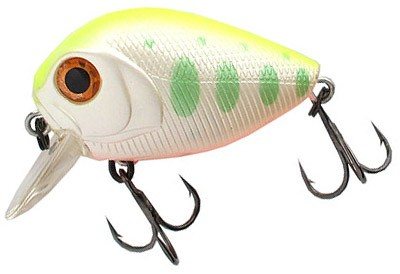
Wobblers Crank (cranks)
Some anglers call Crank class wobblers “baits for dummies.” The reason for such an offensive popular nickname is that they do not require any additional animation with the bait when retrieving.
They all have their own game, which, when retrieved, is transmitted to the tip of the rod by characteristic vibrations. Some have an overly aggressive game, some not so much... But all wobblers of this class, without exception, are united by the possibility of using them on a uniform retrieve. Let's bypass for now such an extreme as twitching cranks.
Almost all predators of our reservoirs love baits of this class. I have caught pike, perch, and chub with them, in general, my opinion is that this is exactly the class that a beginner spinning rod needs.
The main characteristic by which “Crank” is selected is the wiring depth. The most versatile and popular are baits with a depth of 1 to 2.5 meters. I try to do the wiring as close to the bottom of the reservoir as possible, without rising more than a meter from it. However, here is a huge disadvantage of this group of baits - an absolute guarantee of a dead hook for bottom debris.
The cranks, of course, partially fight off obstacles with their spatula, but in fact, breaking the wobbler is a matter of time. The way out of this situation can be to stop the wiring as soon as the blade strikes the bottom. Then, after waiting a little until the crank floats up (the model should be floating), you can continue reeling in the fishing line. By the way, if you do this intentionally, alternating retrieves and pauses, you will get a new approach to catching a predator. In the water, such a crank looks like a feeding fish that doesn’t notice anything. And this is already a signal to attack.
Another way to seduce a predator is to deliberately scrape the bottom with a spatula, stopping briefly to allow the fish to surface a little. The imitation of a swarming fish, which does not notice anything around, attracts pike perch and pike well. But such wiring is fraught... Therefore, the bottom of the reservoir should be as clean as possible, since I repeat - not all cranks are good at repelling obstacles.
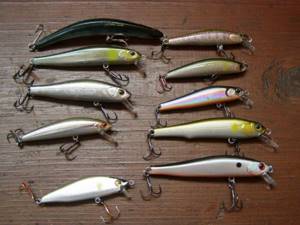
Wobblers Minnow (minou)
A characteristic visual feature of the Minnow class bait is its elongated body, somewhat reminiscent of our bleak (overwater). A secondary sign (not always mandatory) is the absence of any play or vague attempts to “wag the tail” on a uniform retrieve.
But, strange as it may sound, such wobblers can bring you much more bites compared to cranks. You just need to learn a little more about the technique of wiring twitching baits. They have their own technique called “twitching”. According to the wiring, minou are popularly called twitching wobblers.
This wiring is a series of jerks and pauses during which the fish “comes to life”. In the water, it becomes like a fry shying away or prowling in different directions. Twitching is a multifaceted topic, so I have prepared a whole section for it, where these facets will be discussed.
Twitching minnows can stir up even passive fish. This is their main positive quality. However, using deeper water models it is difficult to track the fish's play. In such cases, I rely on intuition (I draw in my head an approximate trajectory of movement for a certain jerk) and experience.
Training near the shore helps a lot when mastering new patterns. Having achieved a good result (game), you can start fishing. It usually takes no more than ten minutes to master a new product. So don’t be lazy and first test the bait in open water, where you will see what mistakes you make.
But in the vast majority of cases, Minnows are used in shallow areas of reservoirs with depths of up to 1-1.5 meters. Fishing at shallow depths gives the best results. It is important to choose wobblers with neutral buoyancy, which hover in the water column during pauses. A fry frozen in place causes a grasping reflex in the predator and forces it to bite.

How to make the longest cast?
In our recent articles, we looked at how to make the correct cast, deal with wind directions and correct the work of the rod. We also looked at the problem of the rod overlapping around the guides and subsequent line breaks. Today we will look at several theses on how to achieve the longest cast and at the same time maintain accuracy.
fishing line
The most important thing in a fishing line if you want to cast very far is its diameter. At the moment there are several options for monofilament fishing line with diameters of 0.25-0.26 mm. They are produced by Fun Fishing, Shimano, and FOX has released this line since last fall. We successfully caught it at the last competitions, we really liked it and for the next season we decided to switch to FOX Exocet 0.26. Before this, we always used Shimano fishing line, but it is one and a half times more expensive than FOX. We even did a review of this fishing line - here.
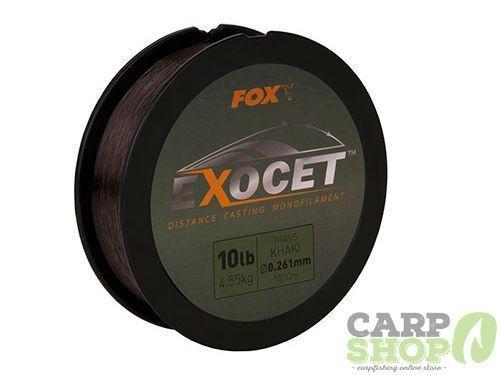
Shock leader
be sure to use a shock leader. The optimal length of the shock leader is a length that will be sufficient so that, with enough overhang of the equipment, there will be at least three turns of the shock leader on the spool. We always use a braided shock leader. According to our observations and experience, a longer distance can be achieved with a braided shock leader than with a mono leader. Although the monoleader does make it much easier to catch fish under the shore.
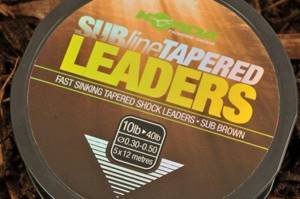
Sinker shape and weight
Bullet. There's not much to talk about here. The most aerodynamic shape, the best flight qualities. The bullet shape of the sinker is the most popular among all anglers who want to fish far from the shore. As for the weight, it usually ranges from 4.5 to 5 ounces. Such heavy sinkers help to load the form well, and at the same time, even at a distance of 150-160 meters, you can tighten the line and record the bite. Sinkers are suitable for any well-known carp companies that everyone knows.
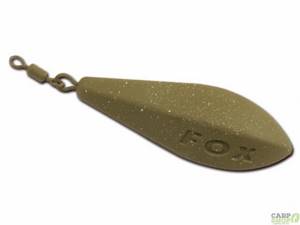
Rod
We are currently using Horizon X5, but this is a competition. Watch our video with a review of the Exocet 0.26 fishing line; we cast the rig with a FOX EOS rod at 150 meters. The main thing is the test and length. The length should be 13 feet and test 3.5 ounces. So you can easily use a 4 oz sinker on a 3.5lb rod. On regular fishing trips, 150 meters is above the roof. Of course, this may not be enough for sports, but in sports the requirements for equipment are completely different.
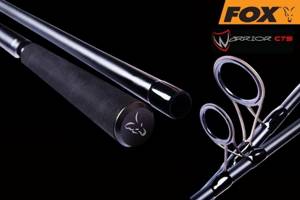
How to prevent the equipment from getting tangled?
We catch with a helicopter, and sometimes we don’t catch with a helicopter and we still don’t get confused. The answer is simple - a small stick. We make a stick for long casts of about 1.5-2cm, and we always wait for the clip to hit before the rig touches the water. If this does not happen, we reel it in and make another cast. We will throw over and over again until we are absolutely sure that the rig is positioned the way we wanted. Don’t be afraid to waste time; if you’re not sure, re-cast.

If you don’t throw to the point with the stick and the only way out is to remove the stick, then you should throw clearly into the clip. When you hit the clip, the rig will stretch into a line and lie parallel to the water. In this case, it would be better if your partner monitors the flight of the rig, ideally catching the splashdown point with binoculars or a rangefinder and making sure that the rig stretches into a string after hitting the clip and does not get wrapped around the leadcore. But we are now talking about the most extreme distances.

Clipping
We always clip exactly the same way, with a marker and a spod. Purely mathematical if you calculate that the straight line to the fishing point on the surface of the water and the depth are two legs, and the distance from the shore to the fishing point on the bottom is the hypotenuse. Simply by calculating using the Pythagorean theorem, you will understand that the error there is so insignificant that the meaning of all these distance adjustments that many people talk about is generally unclear. You will say if there are obstacles on the way to the fishing point - well, here you were working as a marker and had to explore everything. This is a slightly different topic, we are just talking about what length to measure on the fishing lines.
So, it’s always the same on all fishing lines – marker braid, spod, and working rods. Moreover, you must realize that carp fishing is a constant spread of equipment, rockets in a 5 by 5 meter square for the best athletes, and even 10 by 10 meters for ordinary fishermen. Therefore, there is absolutely no need to measure centimeters. You should be approximately in the area of the fishing point. Even if you move a little to the side, it’s even better, all the big fish are standing away from the spot.
Full or partial copying without the consent of the portal editors is prohibited
Fishing with wobblers
Wobbler selection
All the variety of these baits requires certain skills, abilities and good knowledge of the reservoir. Since not every angler can afford to have a whole box of “fish for all occasions,” to select a wobbler, determine the following characteristics of the reservoir:
- depth;
- current speed;
- water color.
For deep areas and murky water, choose bright colors. For fishing in the current, do not take wobblers with large “blades” and excessively high frequencies - their play will be disrupted. It doesn't hurt to know what kind of fish you want to catch. Pike loves large slow-moving baits, pike perch loves elongated mines for bleak, and give perch any little thing, as long as it moves quickly. Finally, I will say that before buying something new, I first try to get as much available information as possible and only then finally make my choice.
Now a few words about the cons. The only but huge disadvantage of wobblers is their price. I'm not talking about cheap Chinese fakes for $1.5-2. For example, it is said that I began my acquaintance with Chinese baits, which flooded all markets. I bought a dozen, came to the river, tested them one by one, and a little later threw them all in the trash.
The reason is the lack of play (they float like a piece of tied wood) and, as a result, a zero result. Therefore, I advise you, it is better to buy one branded working wobbler, and not ten Chinese ones, and do not repeat the mistakes of others!


